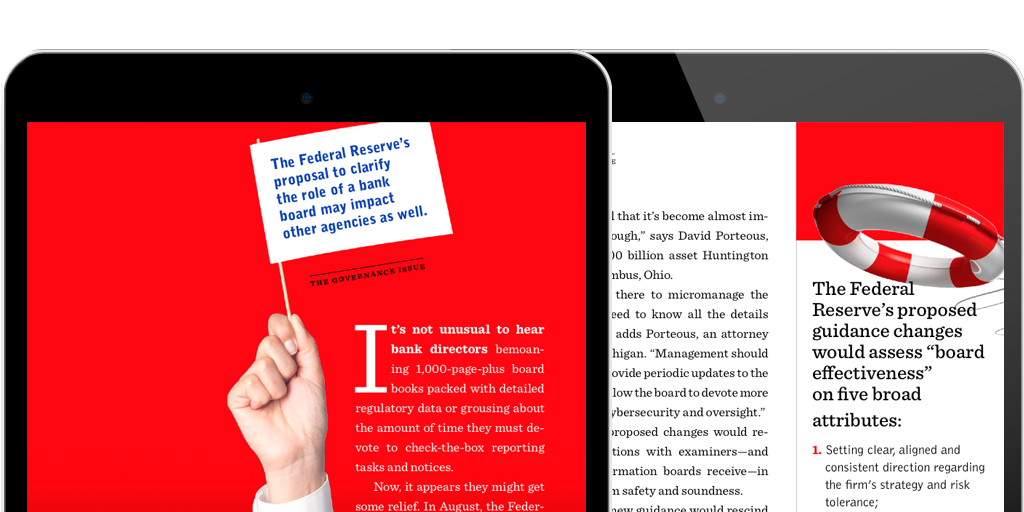
Bank Boards Could Get Some Relief, Finally

It’s not unusual to hear bank directors bemoaning 1,000-page-plus board books packed with detailed regulatory data or grousing about the amount of time they must devote to check-the-box reporting tasks and notices.
Now, it appears they might get some relief. In August, the Federal Reserve proposed a sweeping, three-part overhaul of how involved it expects bank boards to get in addressing regulatory concerns and how it gauges the effectiveness of boards.
The proposed guidance, which was open for comment through Oct. 10, would delineate the duties of management and the board more succinctly, and dial back boards’ involvement in the minutiae of their institutions’ day-to-day operational lives.
Regulatory expectations for the board-and director attention-would be refocused on big-picture concerns, such as strategy, management oversight and risk-management practices.
“The quintessential issue is that there’s been a blurring of the lines of responsibility between management and the board,” says Thomas Vartanian, a partner and regulatory advisor at Dechert, a Washington, D.C., law firm. “Day-to-day management is not a responsibility that boards can or should effectively undertake.”
Fed Gov. Jerome Powell cautioned attendees at a Fed-sponsored director conference in late August that the proposal isn’t intended to “lower the bar for boards or lighten the loads of directors,” but rather “to enable directors to spend less board time on routine matters and more on core board responsibilities.
“We need to allow boards of directors and management to spend a smaller portion of their time on technical compliance exercises, and more time focusing on the activities that support sustainable economic growth,” Powell added.
The proposed changes, which are the result of a three-year review process by the agency, will likely be modified after the comment period. Even so, directors are pleased by the basic gist of the reforms, saying their plates are so filled with regulatory busywork that they don’t have enough time to perform core oversight duties.
“There has been a tendency to give the board so much information and material that it’s become almost impossible to sort through,” says David Porteous, lead director at $102 billion asset Huntington Bancshares in Columbus, Ohio.
“Boards aren’t there to micromanage the bank. They don’t need to know all the details about these issues,” adds Porteous, an attorney from Reed City, Michigan. “Management should address them and provide periodic updates to the board. That would allow the board to devote more time to things like cybersecurity and oversight.”
Critics say the proposed changes would reduce board interactions with examiners-and the amount of information boards receive-in ways that could harm safety and soundness.
If approved, the new guidance would rescind or revise 170 supervisory expectations for boards in 27 different supervision and regulation letters issued over the past decade, and replace them with 33 principles-based expectations for “effective boards.”
Those new expectations center on five general attributes, such as setting a clear direction for the company, holding senior management accountable and supporting independent risk management and internal audit.
For boards of holding companies with more than $50 billion in assets, a new large financial institution rating system would assess the board’s effectiveness based on three measures: governance and controls, capital planning and positions, and liquidity risk management.
“Boards need to be aware of their own strengths and weaknesses, and ensure that directors bring an appropriately diverse range of skills, knowledge, experience and perspective,” Powell told the conference attendees. “An effective board takes a preventative approach and engages in probing self-assessments regularly and systematically.”
The third change would task management directly, not the board, with handling those time-consuming “matters requiring attention” (MRA) and “matters requiring immediate attention” (MRIA) notices and other corrective-action concerns raised by examiners.
The board, which has received (and felt compelled to act on) MRAs and MRIAs since 2013, would only get involved when management doesn’t take appropriate action or there’s a governance-related issue at play.
“Boards often devote a significant amount of time satisfying supervisory expectations that do not directly relate to the board’s core responsibilities,” the official Fed notice states.
“Boards completing such non-core tasks may do so at the expense of sufficiently focusing on their core responsibilities, which when exercised effectively promote the safety and soundness of the firm,” it adds.
Some of the changes, most notably the board effectiveness guidelines, would apply only to holding companies with more than $50 billion in assets, which are regulated by the Fed, and wouldn’t have a direct impact on most bank boards.
But at the behest of President Trump, the Fed is working with two other large federal regulatory agencies-the Office of the Comptroller of the Currency and the Federal Deposit Insurance Corp.-to simplify and harmonize regulations.
“I would expect the other agencies to follow suit, especially since they have new appointees running them,” Vartanian says.
Not everyone is a fan of changing things. Sheila Bair, former chairman of the Federal Deposit Insurance Corp., told The New York Times that allowing management to decide what to share with the board was “problematic. … I think bank examiners feel their findings have more weight with management when the board is also in the loop.”
She suggested that boards at least be copied on correspondences with regulators. Others argue that, given the current climate toward bank boards, directors could be blindsided by a change that prevents them from getting crucial information.
“It is manifestly unfair to hold the board responsible for matters about which they may not have been aware” because examiners or management didn’t share it, wrote Dennis Wall, an attorney and author in Winter Springs, Florida, in a comment letter to the Fed.
Richard Riese, a principal of SMAART Consulting, an Upper Marlboro, Maryland, compliance and risk management consultant, counters that being too close to operational details can make a board less capable of providing good oversight.
“There’s a fine line here, but boards that get too involved in operational details are essentially committing themselves personally to management’s decisions,” he says. “If something does go wrong, they’re unable to address it effectively because they are part of the problem.”
Either way, the Fed’s move signals that “we’re at a high-water mark of regulation and the reaction to the Great Recession,” says Robert Voth, head of the commercial and consumer financial services practice at Russell Reynolds, a search firm.
The unspoken silver lining in all this, Voth says, is what it could mean for board composition. In recent years, risk and compliance expertise has trumped other considerations in director searches. At the same time, workloads have made it tougher to attract good candidates.
Easing the regulatory burden should open the door to building boards with greater diversity and technical expertise. “We’re entering a period where financial institutions can do a wholescale refreshment of their boards, ushered in by the Federal Reserve,” Voth says.
In a world filled with disruptive technologies, cyber risks and competitive threats, easing some of the regulatory burden should allow bank boards to recruit, and think, more strategically.

Join OUr Community
Bank Director’s annual Bank Services Membership Program combines Bank Director’s extensive online library of director training materials, conferences, our quarterly publication, and access to FinXTech Connect.
Become a Member
Our commitment to those leaders who believe a strong board makes a strong bank never wavers.

